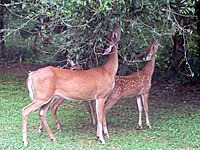
Photo from wikipedia
Abstract Understanding of how biodiversity can recover after anthropogenic disturbances, such as selective logging, is important for planning conservation strategies for tropical forests and for more sustainable timber harvest regimes.… Click to show full abstract
Abstract Understanding of how biodiversity can recover after anthropogenic disturbances, such as selective logging, is important for planning conservation strategies for tropical forests and for more sustainable timber harvest regimes. However, the knowledge of insect community compositions in regenerating logged forests is still limited, especially in the Afrotropics. Here, we evaluated the recovery patterns of fruit-feeding butterfly communities in four different-aged secondary forest compartments and one primary forest compartment in the Budongo Central Forest Reserve, Uganda. In each compartment, butterflies were sampled monthly for five consecutive months in 2017 using traps baited with fermented bananas. A total of 3,778 individuals, representing 82 species (78 identified at the species level and four morphogroups) were recorded. The fruit-feeding butterfly community composition differed among forest compartments and study months. Fruit-feeding butterfly communities of the oldest 72-year-old secondary forest compartment were similar to the primary forest compartment. In the younger secondary forest compartments the seasonal variation was large; especially the communities of the “core” rainy season months were distinct from the communities in primary and oldest secondary forest. The majority of individuals captured from both primary and secondary forests represented forest-dependent species. Primary forests are irreplaceable for preserving the diversity of tropical forests in the long-term. Nevertheless, our study demonstrates that selective logging can allow fruit-feeding butterfly community composition to recover if enough time (>70 years) is allowed for recovery.
Journal Title: Forest Ecology and Management
Year Published: 2021
Link to full text (if available)
Share on Social Media: Sign Up to like & get
recommendations!